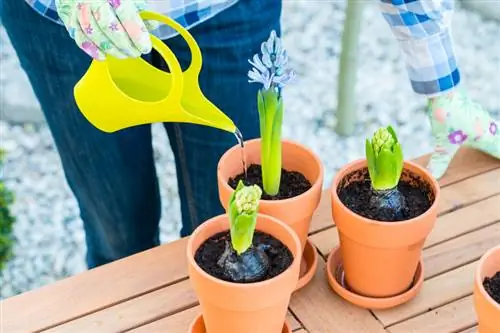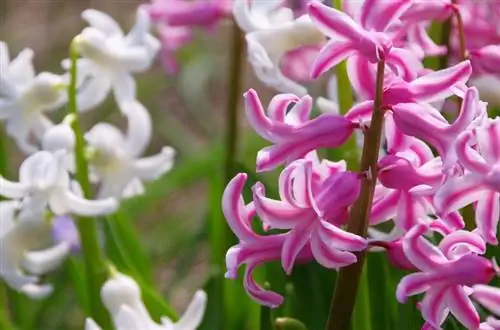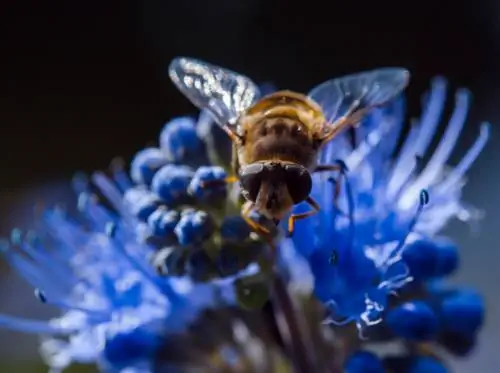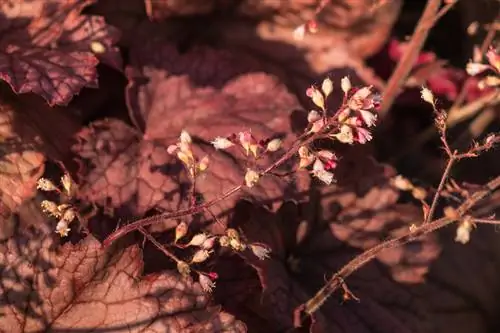- Author admin [email protected].
- Public 2023-12-16 16:46.
- Last modified 2025-01-23 11:21.
According to a Greek legend that is thousands of years old, the colorfully blooming hyacinths were created from the blood of the beautiful young man Hyakinthos, who was accidentally killed by the god Apollo. The spring bloomer still fascinates people today, as its splendor can be seen in numerous bright colors. Fortunately, bulbous flowers are easy to plant and care for. The tips in the following article will tell you what you should pay attention to.
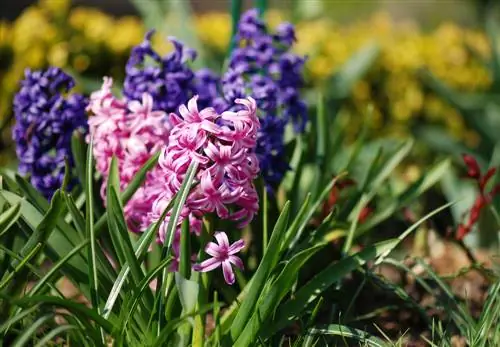
What are the characteristics of garden hyacinths?
Garden hyacinths, also known as Hyacinthus orientalis, are colorful spring bloomers with intensely fragrant clusters of bell-shaped flowers. They prefer a sunny location, loose soil and can be cultivated in the garden as well as in pots. Hyacinth bulbs are hardy and perennial.
Origin and distribution
Our garden hyacinths are of course not the original Hyacinthus plant, but instead are hybrid varieties that have emerged primarily from the wild species Hyacinthus orientalis. This originally comes from the Mediterranean region and grows primarily in Syria, Turkey and Lebanon on rocky, barren substrates and at mountainous altitudes of up to 2000 meters.
The first plants reached Europe as early as the 16th century and quickly became very popular, especially in aristocratic circles. Through breeding and selection, numerous new varieties in many colors were created within just 100 years.
Usage
Hyacinths are now available in stores from January onwards, with the flowers then planted in special glasses or planters and begin to bloom as soon as they are purchased.
In addition to keeping them in pots, the bulbs are often planted in the garden, where their early flowering makes them one of the first signs of spring.
Appearance and growth
Depending on the variety, hyacinths grow between 15 and 30 centimeters high. Like all bulbous flowers, they have a short growing season, during which the first leaf tips become visible as early as February. A tuft of leaves develops from this, which in turn encloses the strong flower stem. The plant has already faded in July and is preparing for overwintering.
Hyacinth bulbs are perennial and sprout every year. They consist of individual scales that supply and store nutrients. The bulb continually forms new scales from the inside, while the outer ones provide the energy for budding and flowering. In order for you to be able to admire the hyacinth flowers every year, the plants have to store more energy during the growing season than they actually need to bloom. Only then can new scales form. On the other hand, the onion shrinks if the nutrient and water supply is insufficient.
leaves
Hyacinths form between four and seven band-shaped, basal leaves that can be up to 30 centimeters long and two centimeters wide. They shine in a fresh, light green and envelop the flower stem, which appears a little later.
Bloom and flowering time
The flower stem usually sprouts together with the rosette-like leaves. The thick, fleshy stem grows up to 30 centimeters tall and bears a multitude of bell-like flowers arranged in a raceme. As a rule, only one flower stalk develops from each bulb, but very rarely there can be two. How many individual flowers there are on a hyacinth and how large the cluster becomes depends on the variety, the size of the bulb and the location and care conditions.
The very intensely scented hyacinth flowers can be admired from April to May and have an extremely extensive color spectrum: white, red, pink and orange, violet and even blue shades are available. There are also double-flowering and multi-colored varieties.
The individual flowers consist of three petals and three sepals, which grow together and are mostly the same color.
Fruits
Since hyacinths should be cut back after flowering in order to conserve the bulb's reserves, the flower rarely develops fruit.
But if you have missed a flower stem, you can use the seeds that ripen in it for sowing. Hyacinths are angiosperms whose seeds should be sown immediately after the ripe fruit has decayed. They must not dry out, as this will cause them to lose their ability to germinate.
In nature, ants transport seeds so that they germinate in the dark and warm environment of an ant hole. However, it takes a very long time to get there because the seeds first have to go through a warm phase during the summer months and then a cold stratification in the winter. Only then is the germination inhibition broken and the seeds sprout. However, you have to wait between three and five years until the first flowering occurs.
Is garden hyacinth poisonous?
Hyacinths contain calcium oxalate and other toxins that can cause skin irritation. Anyone who frequently handles bulbs and flowers can become ill with so-called hyacinth scabies. This is manifested by redness, pustules and itching, but can also lead to serious inflammation. Onions and other parts of plants should not be consumed because they cause stomach and intestinal problems, including vomiting and diarrhea.
Furthermore, the plant is poisonous to animals: cats, dogs, horses as well as rodents (guinea pigs, hamsters, rabbits) and birds can suffer more or less severe symptoms of poisoning from eating plant and onion peels. Since the toxins irritate the mucous membranes, increased salivation and difficulty swallowing, including cramps, vomiting and diarrhea, typically occur.
Which location is suitable?
The bulb flowers prefer a warm and sunny location. This should be protected from weather influences such as cold and rain. You can cultivate hyacinths in the garden bed as well as in pots or other planters on the balcony or terrace.
Floor
Hyacinths like loose, mineral or humus-rich soil, but it should not be too moist. Good drainage is important so that the bulbs do not start to rot in the humid environment. To do this, you can, for example, add a layer of sand about five centimeters thick to the ground under the bulbs, which will allow excessive moisture to seep away quickly.
pot culture
The spring bloomer can be easily cultivated in small pots or planted in groups in larger planters, although you have to supply the plants with water regularly. The onion must not dry out, but it must not be too moist either. Excess water should not remain in the planter or saucer, but should be removed immediately after watering. If the hyacinth roots sit in water for too long, they rot and so does the rest of the plant. Normal, commercially available potting soil is suitable as a substrate, which you can mix with a little coarse sand.
Cut off the spent flower stem. However, leave the leaves standing until they have turned yellow and are completely dry. Now place the pots with the onions in a cool, dark room, such as the basement, and let them overwinter there until next spring.
Culture in a glass
Hyacinths have been cultivated in special jars with a bulbous bottom and a curved top for around 100 years. In such a hyacinth glass, you only fill the lower part with water; soil is not necessary. The onion lies in the upper bowl and receives sufficient moisture without coming into direct contact with the water. The onion in the water glass needs to be kept dark and cool for about two to three months, during which time you top up with fresh water every day. Only when the flower stalks and leaves appear do you place the glass on the windowsill.
The disadvantage of this method, however, is that the hyacinth bulb cannot store nutrients due to the lack of fertilization and therefore collapses after flowering and can no longer be used.
Planting garden hyacinths correctly
First, dig a planting hole that should be about twice as deep as the bulb is high. However, the minimum depth is ten centimeters. If the soil is heavy, add a layer of sand to the bottom of the hole to serve as drainage. Mix the excavated material with a good handful of compost and finally place the bulb in the hole. The wide side should point downwards and the narrower side should point upwards. Now fill the soil into the planting hole and press it down lightly. Mark the spot with a bamboo stick or something similar so that you don't accidentally plant something else over it in the spring or even dig up the ground.
What is the best time to plant?
Hyacinth bulbs should be planted in the garden bed between October and November on a mild and dry day.
The correct planting distance
A distance of at least 15 centimeters should be maintained from the neighboring plant.
Watering the garden hyacinth
Hyacinths freshly planted in pots require little water and should therefore not be watered excessively. Only after budding does the water requirement increase slightly. The right time to water again is when the plant substrate has dried on the surface. Never pour directly onto the onion, only around it.
Hyacinth bulbs planted in the garden, on the other hand, do not need to be watered at all, as the soil is usually moist enough during spring.
Fertilize garden hyacinth properly
You should fertilize planted hyacinths with a little compost in early spring, while potted specimens should be placed in fresh substrate if possible.
Cut garden hyacinth correctly
The fleshy flower stem should be removed after flowering to protect the bulb's nutrient reserves. However, do not remove the leaves immediately, but wait until they are yellow and dry. The flower bulb still extracts the nutrients it contains, which is why cutting it out prematurely is unfavorable.
Oversummering / Overwintering
Since the hyacinth's vegetation phase ends in July, simply leave the bulb alone after it has faded. Planted specimens can simply remain in the ground and are covered with spruce and fir branches or a thick layer of leaves in autumn. However, this protective layer must be removed again from February / March as the flowers sprout early in the year. Alternatively, dig up the bulbs in summer, keep them cool, dry and dark and put them back in the ground in autumn. Hyacinth bulbs are absolutely hardy as long as they are not grown in a pot.
Propagate garden hyacinth
Removing the spent hyacinth bulbs in summer has a big advantage: In this way you can separate the breeding bulbs for propagation. In order for these to develop, the flowers need good location and care conditions in the form of sufficient water and a balanced supply of nutrients. You can encourage the mother onions to divide by making deep cross-shaped cuts in the base of the bulb before planting in autumn.
Plant the small onions separately in autumn. The flowers that grow from it will initially be small and sparse, but after about two to three years they will bloom just as profusely as the mother plant. Incidentally, removing the brood onions is not only useful for propagation purposes, but also has advantages for the mother onion: This is deprived of many nutrients as the daughters train.
How do I transplant correctly?
Transplanting to a new location is very easy: all you have to do is dig up the bulbs and replant them in their new location in the fall.
Diseases and pests
Like all bulbous flowers, hyacinths are threatened by soil-dwelling pests such as voles. Above ground, snails and sucking insects such as aphids in particular can taste the juicy foliage.
When it comes to diseases, fungal infections are the main ones that appear during budding in spring. Gray mold caused by the Botrytis fungus is very common and is noticeable as brown spots on the stems and leaves. Infected plants should be removed immediately to avoid infection.
Choose a location that is not too humid and airy to avoid fungal diseases from the outset.
Tip
In the garden, you should support the heavy flower clusters with a wooden stick or something similar, otherwise they tend to bend, especially after long periods of rain.
Species and varieties
The over 200 different varieties of garden hyacinths are divided primarily according to their flower colors. There are white, blue, purple, pink, orange and red varieties, with the purple and blue shades being the most common. The varieties 'Blue Jacket' (blue flowers), the white-flowering 'Carnegie' and the 'Fondant' with its enchanting pink flowers are very popular. The purple-red flowering 'Woodstock', on the other hand, is one of the rarer varieties and is therefore particularly eye-catching.
Varieties like 'Crystal Palace' and 'General Köhler', on the other hand, have densely double, blue flowers, while the white splendor of 'Snow Crystal' is reminiscent of soft snowflakes. 'Prince of Love' has exceptionally salmon pink flowers, 'Hollyhock' impresses with its beautifully double, strong red flowers. Also very rare are varieties with yellowish varieties such as 'Gipsy Queen' and 'Odysseus'.
The different varieties develop very different inflorescences. Some impress with very dense, large flower clusters, others are looser and more delicate. The so-called “Multiflora” varieties, which always produce several flower shoots per bulb, are also an interesting eye-catcher. These include, for example, the blue 'Anastasia' and the pink 'Freestyler'. Multiflora hyacinths usually bloom with loose inflorescences that are less densely covered with individual flowers.


